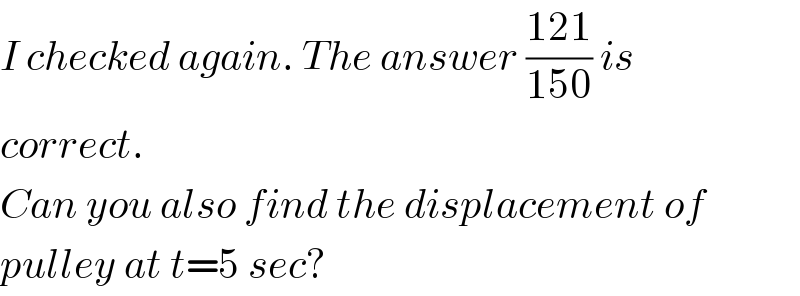
Question Number 23748 by mrW1 last updated on 05/Nov/17

Commented by mrW1 last updated on 05/Nov/17

$$\mathrm{The}\:\mathrm{same}\:\mathrm{question}\:\mathrm{as}\:\mathrm{Q23707}, \\ $$$$\mathrm{but}\:\mathrm{the}\:\mathrm{pulley}\:\mathrm{C}\:\mathrm{has}\:\mathrm{a}\:\mathrm{mass}\:\mathrm{1}\:\mathrm{kg}\:\mathrm{and} \\ $$$$\mathrm{radius}\:\mathrm{5}\:\mathrm{cm}. \\ $$
Answered by ajfour last updated on 05/Nov/17

$${Tension}\:{on}\:{left}\left({A}\:{side}\right)={T}_{\mathrm{1}} \\ $$$${T}_{\mathrm{1}} −{mg}=\mathrm{2}{mA}\:\:\:\:\:\:\:\:\:\:\:\:\:\:\:\:\:...\left({i}\right) \\ $$$${F}−{T}_{\mathrm{1}} −{T}_{\mathrm{2}} −{mg}={mA}\:\:\:\:\:\:\:\:\:\:\:\:\:\:\:\:\:\:\:....\left({ii}\right) \\ $$$$\left({T}_{\mathrm{2}} −{T}_{\mathrm{1}} \right){r}\:=\left(\frac{{mr}^{\mathrm{2}} }{\mathrm{2}}\right)\left(\frac{{A}}{{r}}\right)\:\:\:\:...\left({iii}\right) \\ $$$$\Rightarrow\:\:{T}_{\mathrm{2}} ={T}_{\mathrm{1}} +\frac{{mA}}{\mathrm{2}} \\ $$$${using}\:{in}\:\left({ii}\right): \\ $$$${F}−\mathrm{2}{T}_{\mathrm{1}} =\frac{\mathrm{3}{mA}}{\mathrm{2}}+{mg}\:\:\:\:\:\:\:\:\:\:\:\:\:\:\:\:.....\left({iv}\right) \\ $$$${Block}\:{A}\:{is}\:{lifted}\:{when}\:{T}_{\mathrm{1}} ={mg} \\ $$$${so},\:\:\:\:\:{F}=\mathrm{3}{mg}\:\:\:\:\:\:\:\left({A}\:=\mathrm{0}\:{till}\:{then}\right) \\ $$$$\Rightarrow\:\:\:\:\:\mathrm{20}{t}=\mathrm{30}\:\:\:\:{or}\:\:\:\boldsymbol{{t}}=\frac{\mathrm{3}}{\mathrm{2}}{s} \\ $$$${From}\:\left({iv}\right)\:{and}\:\left({i}\right): \\ $$$${F}−\mathrm{2}\left({mg}+\mathrm{2}{mA}\right)=\frac{\mathrm{3}{mA}}{\mathrm{2}}+{mg} \\ $$$${or}\:\:\:\mathrm{20}{t}−\mathrm{30}=\frac{\mathrm{11}{A}}{\mathrm{2}} \\ $$$${A}=\frac{\mathrm{40}}{\mathrm{11}}\left({t}−\frac{\mathrm{3}}{\mathrm{2}}\right) \\ $$$${this}\:{is}\:{valid}\:{till}\:{T}_{\mathrm{2}} \:\leqslant\mathrm{2}{mg} \\ $$$${Eliminating}\:{T}_{\mathrm{1}} \:{from}\:\left({i}\right)\:{and}\left({iii}\right) \\ $$$${T}_{\mathrm{1}} −{mg}=\mathrm{2}{mA}\:;\:\:{T}_{\mathrm{2}} ={T}_{\mathrm{1}} +\frac{{mA}}{\mathrm{2}}+{mg} \\ $$$${T}_{\mathrm{2}} ={mg}+\mathrm{2}{mA}+\frac{{mA}}{\mathrm{2}} \\ $$$${when}\:{block}\:{B}\:{is}\:{lifted}, \\ $$$${T}_{\mathrm{2}} =\mathrm{2}{mg}\:\Rightarrow\:\:\:\frac{\mathrm{5}{mA}}{\mathrm{2}}={mg} \\ $$$${A}=\frac{\mathrm{2}{g}}{\mathrm{5}}\:\:\:{or}\:\:\:\frac{\mathrm{40}}{\mathrm{11}}\left({t}−\frac{\mathrm{3}}{\mathrm{2}}\right)=\frac{\mathrm{2}{g}}{\mathrm{5}} \\ $$$$\:\:\:\:\:\:\:\:\:\:\:\:\:\:\:\:\:\:{t}=\frac{\mathrm{11}}{\mathrm{10}}+\frac{\mathrm{3}}{\mathrm{2}}\:=\mathrm{2}.\mathrm{6}{s} \\ $$$${s}_{{p}} \:=\:\int_{\mathrm{3}/\mathrm{2}} ^{\:\:\mathrm{2}.\mathrm{6}} {v}_{{p}} {dt} \\ $$$${v}_{{p}} =\:\int_{\mathrm{3}/\mathrm{2}} ^{\:\:{t}} {Adt}\:=\:\frac{\mathrm{40}}{\mathrm{11}}\int_{\mathrm{3}/\mathrm{2}} ^{\:\:{t}} \left({t}−\frac{\mathrm{3}}{\mathrm{2}}\right){dt} \\ $$$$\:\:\:\:\:=\frac{\mathrm{20}}{\mathrm{11}}\left({t}−\frac{\mathrm{3}}{\mathrm{2}}\right)^{\mathrm{2}} \\ $$$$\:\:\:\:\:\:{s}_{{p}} =\frac{\mathrm{20}}{\mathrm{11}}\int_{\mathrm{3}/\mathrm{2}} ^{\:\:\mathrm{2}.\mathrm{6}} \left({t}−\frac{\mathrm{3}}{\mathrm{2}}\right)^{\mathrm{2}} {dt} \\ $$$$\:\:\:\:=\frac{\mathrm{20}}{\mathrm{11}}×\frac{\mathrm{1}}{\mathrm{3}}×\left(\frac{\mathrm{11}}{\mathrm{10}}\right)^{\mathrm{3}} =\frac{\mathrm{121}}{\mathrm{150}}\:{m}\:\approx\:\mathrm{0}.\mathrm{8}{m} \\ $$$$\:\:\left({s}_{{p}} \:{by}\:{the}\:{time}\:{block}\:{B}\:{is}\:{lifted}\right). \\ $$$$\:\:{still}\:{the}\:{same}\:{answer}..! \\ $$
Commented by mrW1 last updated on 05/Nov/17

$${I}\:{checked}\:{again}.\:{The}\:{answer}\:\frac{\mathrm{121}}{\mathrm{150}}\:{is} \\ $$$${correct}. \\ $$$${Can}\:{you}\:{also}\:{find}\:{the}\:{displacement}\:{of} \\ $$$${pulley}\:{at}\:{t}=\mathrm{5}\:{sec}? \\ $$
